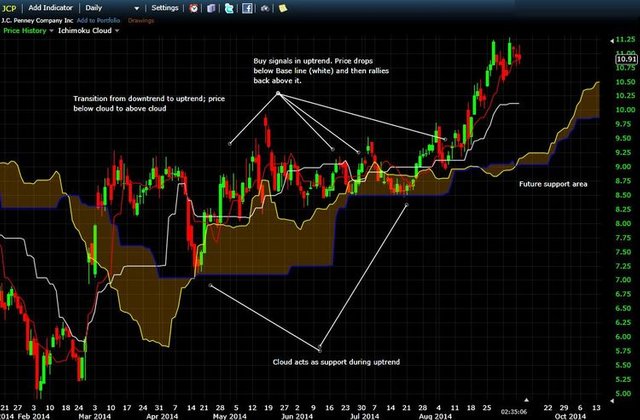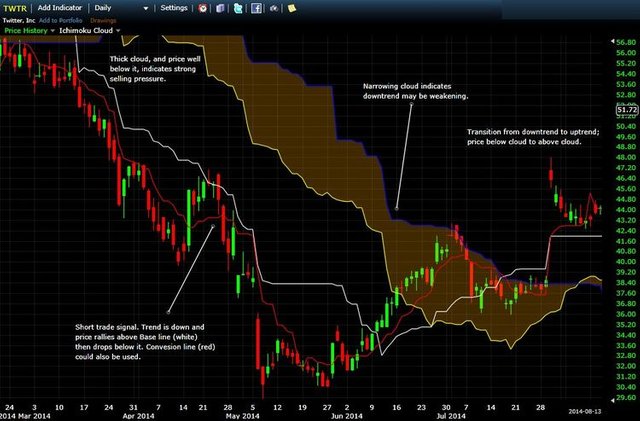The Ichimoku Cloud is a marker intended to let you know all that you have to think about a value pattern, including its bearing, force, dynamic help and opposition levels, and even exchange signals. The Japanese name—Ichimoku Kinko Hyo—signifies "one look (or look) balance outline."
From the start, the Ichimoku Cloud really looks a little startling when connected to the diagram, yet once you realize how to utilize it, it's straightforward and accommodating, particularly in case you're a more current broker and need potential help and opposition regions and pattern heading featured for you.
What Is the Ichimoku Cloud?
Goichi Hosoda, a Japanese writer, discharged this pointer in his 1969 book, which uncovered around three decades worth of exchanging research.
Ichimoku Cloud incorporates five lines, each giving data about the value activity. The separation between two of these is filled in, making a cloud-like appearance. For some brokers who utilize this marker, the "cloud" is the predominant factor, and what they center around.
Ichimoku Cloud can be utilized on different time periods or markets.

Ichimoku Cloud Components and Calculations
The accompanying computations depend on default marker esteems, for example, utilizing nine periods for the Conversion Line. These defaults can be effectively balanced on an outlining stage, for example, FreeStockCharts.com or StockCharts.com, to suit an individual dealer's needs.
The red line in Figure 1 is Tenkan-Sen (Conversion Line). It's the midpoint of the last nine value bars: [(9-period high + 9-period low)/2].
The white line is Kijun-sen (Base Line). It's the midpoint of the last 26 value bars: [(26-period high + 26-period low)/2].
The yellow line is Senkou Span A (Leading Span A). It's the midpoint of the over two lines: [(Conversion Line + Base Line)/2]. This worth is plotted 26 periods into what's to come.
The blue line is Senkou Span B (Leading Span B). It's the midpoint of the last 52 value bars: [(52-period high + 52-period low)/2]. This worth is plotted 26 periods into what's to come.
The green line is the Chickou Span (Lagging Span), and will consistently linger behind the value; it's the latest cost, plotted 26 periods back. This line isn't utilized in the techniques portrayed underneath, and along these lines has been expelled in those related figures to decrease diagram mess.
How is Ichimoku Cloud Used?
The cloud offers the most potential for brokers, since it is anything but difficult to translate and gives prescient help and opposition levels anticipated out 26 periods from the present time frame. Here are the manners in which the cloud is utilized to survey value activity.
Pattern Confirmation: When the cost is over the cloud it demonstrates an upswing, when the cost is beneath the cloud it shows a downtrend.
Pattern Strength or Weakness: When Span A (yellow) is going far up into the clouds from Span B (blue) it shows the upswing is picking up force. At the point when Span An is going down and away from Span B it demonstrates the downtrend is quickening. At the end of the day, a thickening cloud affirms the present pattern. A dainty cloud indicates hesitation, and a possibly feeble or debilitating pattern.
Backing and Resistance: The cloud is anticipated out 26 value bars to one side of the present cost, giving a thought of where backing and obstruction may create later on. During an upturn, the cost will regularly ricochet off the cloud during pullbacks and afterward continue the upswing. During a downtrend, the cost will frequently backtrack to the cloud and afterward proceed with lower. Along these lines, the cloud presents passage openings into the pattern.
Hybrid Signals: If the pattern is up (cost above cloud and Span An is above Span B), and the Conversion line falls beneath the Base line and afterward arouses back above it, it flag a long section. In the event that the pattern is down (cost underneath cloud and Span An is beneath Span B), and the Conversion line mobilizes above Base line and afterward drops back beneath it, it flag a short section.
Another passage sign includes the cost and the Base line (can likewise utilize Conversion line). In the event that the pattern is up and the value dips under the Base line, purchase when the value revitalizes back over the Base line. In the event that the pattern is down and the value moves over the Base line, short sell when the value drops back through the Base line.
Translating Ichimoku Cloud
Indeed, even on the rough, yet drifting, JCP every day outline in Figure 2, the Ichimoku Cloud pointer would have been valuable.
At the extreme left the cost is in a downtrend, however when the cloud neglects to go about as opposition, and value moves above it, that development flagged a potential pattern inversion. Since the cost is over the cloud, the cloud goes about as help, and gives a few exchange sign to get into the rising upswing.
Figure 3 demonstrates an exceptionally solid downtrend in TWTR as the value exchanges well underneath the cloud and the cloud is likewise very thick all through the huge decreases. One short exchange is given by the value crossing over the Base (or Conversion) line and after that dropping back beneath. As the value ascends in June, the Cloud limits, demonstrating the downtrend is losing energy. In late July the value breaks completely over the cloud, demonstrating a pattern inversion. 
Ichimoku Cloud Limitations
Like most pointers, Ichimoku Cloud just gives data on the timespans being examined, despite the fact that the cloud is anticipated out into what's to come. This implies there might be bigger patterns at work that the pointer doesn't represent, and false exchange sign or information might be created. For instance, the predominant pattern might be down, yet the cost could rally over the cloud on a retracement, just to keep falling inside the downtrend a brief timeframe later.
The cloud is likewise just basically a couple of moving modified moving midpoints, which may or not offer help during an upswing, or opposition in a downtrend.
All estimations are additionally founded on chronicled information, which means exchange sign may show up late or at inauspicious occasions, in light of the fact that recorded momentary propensities (which the marker catches) may not rehash later on.
The Bottom Line
The Ichimoku Cloud is a valuable marker, particularly for new brokers who need some assistance with measuring pattern bearing, energy, spotting pattern inversions and discovering passage focuses. Merchants will in any case need to control hazard with a stop misfortune and furthermore figure out how to beneficially leave exchanges. With every one of its lines, the Ichimoku Cloud can seem frightening, yet fundamentally if the cost is beneath the Cloud, the pattern is down; search for short positions and evade long positions. At the point when the cost is over the Cloud, the pattern is up; search for long positions and maintain a strategic distance from short positions.
The modern digital forex market moves fast, with high levels of speed and velocity. Subsequently, reversal trading can be a risky and potentially dangerous strategy when not executed to perfection. As such, why not look to brush up on your forex knowledge and strategy by LISTENING our FREE Advanced Forex Trading Guide PODCAST or AUDIOBOOK?
This Guide will help you for Making Money & You’ll Learn the Secrets of Forex Market Strategies to the Fundamental Basics of Being a Currency Trader Today! You can sign up right here to get your free audiobook --->> https://amzn.to/2N3RPE2
Hi! I am a robot. I just upvoted you! I found similar content that readers might be interested in:
http://vantagetrade.com/ichimoku-trading-strategy/
Downvoting a post can decrease pending rewards and make it less visible. Common reasons:
Submit